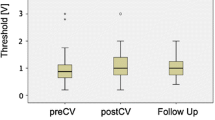Abstract
Low energy internal cardioversion is a safe and highly effective method for atrial fibrillation termination. We will describe 6 patients in whom the conventional 2-electrode systems with the defibrillation leads positioned in the right atrium and in the coronary sinus or left pulmonary artery failed to terminate the arrhythmia despite the use of maximal available energies. A 3-electrode configuration including right atrium, coronary sinus and left pulmonary artery was used in order to encompass as much atrial mass as possible between the cathode and the anode. The atrial fibrillation was successfully interrupted in 4 out of 6 patients. The creation of a 3-electrode configuration may be a further technical expedient in order to increase the success rate of internal cardioversion when usual manoeuvres like lead repositioning, reversion of polarity, or addition of antiarrhythmic drugs are ineffective.
Similar content being viewed by others
References
Alt E, Schmitt C, Ammer R, Coenen M, et al. Initial experience with intracardiac atrial defibrillation in patients with chronic atrial fibrillation. PACE 1994;17:1067–1078.
Murgatroyd FD, Slade AKB, Sopher SM et al. Efficacy and tolerability of transvenous low energy cardioversion of paroxysmal atrial fibrillation in humans. J Am Coll Cardiol 1995;25:1347–1353.
Alt E, Schmitt C, Ammer R, et al. Effect of electrode position on outcome of low-energy intracardiac cardioversion of atrial fibrillation. Am J Cardiol 1997;79:621–625.
Cooper RAS, Alferness CA, Smith WM, Ideker RE. Internal cardioversion of atrial fibrillation in sheep. Circulation 1993;87:1673–1686.
Kalman JM, Power JM, Chen JM, et al. Importance of electrode design, lead configuration and impedance for successful low energy transcatheter atrial defibrillation in dogs. J Am Coll Cardiol 1993;22:1199–1206.
Alt E, Ammer R, Schmitt C, et al. A comparison of treatment of atrial fibrillation with low-energy cardioversion and conventional external cardioversion. Eur Heart J 1997;18:1796–1804.
Krum D, Hare J, Mughal K, et al. Optimization of shocking lead configuration for transvenous atrial defibrillation. J Cardiovasc Electrophysiol 1998;9: 998–1003.
Lok NS, Lau CP, Tse HF, Ayers GM. Clinical shock tolerability and effect of different right atrial electrode locations on efficacy of low energy human transvenous atrial defibrillation using an implantable lead system. J Am Coll Cardiol 1997;30:1324–1330.
Levy S, Richard P, Lau C, et al. Multicenter lowenergy transvenous atrial defibrillation (XAD). Trial results in different subsets of atrial fibrillation. J Am Coll Cardiol 1997;29:750–755.
Gasparini G, Bonso A, Perkan A, et al. Persistent atrial fibrillation: clinical outcome of patients refractory to external electrical cardioversion and treated Three-electrode system for atrial cardioversion 255 with internal atrial defibrillation (abstr). PACE 1999;22(Pt II):895.
Schmitt C, Alt E, Plewan A, et al. Low energy intracardiac cardioversion after failed conventional external cardioversion of atrial fibrillation. J Am Coll Cardiol 1996;28:994–999.
Lau CP, Lok NS. A comparison of transvenous atrial defibrillation of acute and chronic atrial fibrillation and the effect of intravenous sotalol on human atrial defibrillation threshold. PACE 1997;20:2442–2452.
Santini M, Pandozi C, Toscano S, et al. Low energy intracardiac cardioversion of persistent atrial fibrillation. PACE 1998;21:2641–2650.
Guarnieri T, Levine J, Veltri EP, et al. Success of chronic defibrillation and the role of antiarrhythmic drugs with the automatic implantable cardioverter/defibrillator. Am J Cardiol 1987;60:1061–1064.
Fain ES, Lee JT, Winkle RA. Effects of acute intravenous and chronic oral amiodarone on defibrillation energy requirements. Am Heart J 1987;114:8–17.
Sagrista-Sauleda J, Permanyer-Miralda G, Soler-Soler J. Electrical cardioversion after amiodarone. Am Heart J 1992;123:1536–1542.
Guarnieri T, Tomaselli G, Griffith LSC, et al. The interaction of antiarrhythmic drugs and the energy for cardioversion of chronic atrial fibrillation. PACE 1991;14:1007–1012.
Capucci A, Aschieri D, Villani GQ, et al. Oral amiodarone increases efficacy of DC cardioversion in patients with chronic atrial fibrillation and organic heart disease (abstract). Eur Heart J 1997;18(Suppl):478.
Boriani G, Biffi M, Capucci A, et al. Favorable effects of Øecainide in transvenous internal cardioversion of atrial fibrillation. J Am Coll Cardiol 1999;33:333–341.
Oral H, Souza JJ, Michaud GF, et al. Facilitating transthoracic cardioversion of atrial fibrillation with ibutilide pretreatment. N Engl J Med 1999;340:189–54.
Wang J, Bourne GW, Wang Z. Comparative mechanism of antiarrhythmic drug action in experimental atrial fibrillation. Importance of use-dependent effects on refractoriness. Circulation 1993;88:1030–1044.
Bianconi L, Mennuni M, Lukic V, et al. Effects of oral propafenone administration before electrical cardioversion of chronic atrial fibrillation: a placebo controlled study. J Am Coll Cardiol 1996;28:700–706.
Author information
Authors and Affiliations
Rights and permissions
About this article
Cite this article
Benedini, G., Gardini, A., Toselli, T. et al. Clinical Feasibility of Low Energy Internal Atrial Cardioversion with a Three-Electrode Configuration in Patients with Unsuccessful Conventional Configurations. J Interv Card Electrophysiol 4, 251–256 (2000). https://doi.org/10.1023/A:1009830032399
Issue Date:
DOI: https://doi.org/10.1023/A:1009830032399




